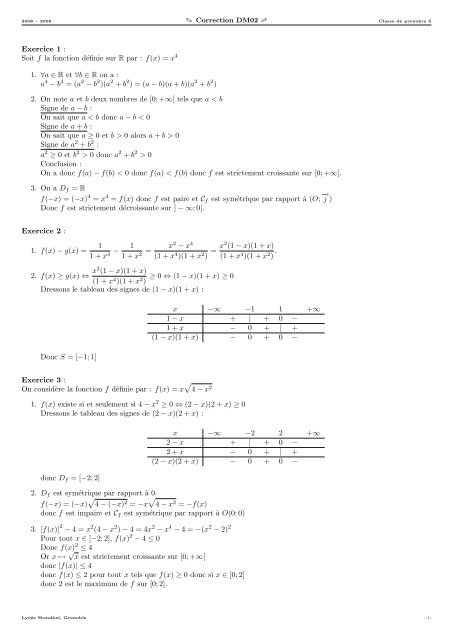f(x) - sites de Vincent Obaton
f(x) - sites de Vincent Obaton
f(x) - sites de Vincent Obaton
Create successful ePaper yourself
Turn your PDF publications into a flip-book with our unique Google optimized e-Paper software.
2008 – 2009 ✎ Correction DM02✎<br />
Exercice 1 :<br />
Soit f la fonction définie sur R par : f(x) = x 4<br />
1. ∀a ∈ R et ∀b ∈ R on a :<br />
a 4 − b 4 = (a 2 − b 2 )(a 2 + b 2 ) = (a − b)(a + b)(a 2 + b 2 )<br />
2. On note a et b <strong>de</strong>ux nombres <strong>de</strong> [0; +∞[ tels que a < b<br />
Signe <strong>de</strong> a − b :<br />
On sait que a < b donc a − b < 0<br />
Signe <strong>de</strong> a + b :<br />
On sait que a ≥ 0 et b > 0 alors a + b > 0<br />
Signe <strong>de</strong> a 2 + b 2 :<br />
a 2 ≥ 0 et b 2 > 0 donc a 2 + b 2 > 0<br />
Conclusion :<br />
On a donc f(a) − f(b) < 0 donc f(a) < f(b) donc f est strictement croissante sur [0; +∞[.<br />
3. On a Df = R<br />
f(−x) = (−x) 4 = x 4 = f(x) donc f est paire et Cf est symétrique par rapport à (O; −→ j )<br />
Donc f est strictement décroissante sur ] − ∞; 0[.<br />
Exercice 2 :<br />
1. f(x) − g(x) =<br />
1 1 x<br />
− =<br />
1 + x4 1 + x2 2 − x4 (1 + x4 )(1 + x2 ) = x2 (1 − x)(1 + x)<br />
(1 + x4 )(1 + x2 ) .<br />
2. f(x) ≥ g(x) ⇔ x2 (1 − x)(1 + x)<br />
≥ 0 ⇔ (1 − x)(1 + x) ≥ 0<br />
(1 + x 4 )(1 + x 2 )<br />
Dressons le tableau <strong>de</strong>s signes <strong>de</strong> (1 − x)(1 + x) :<br />
Donc S = [−1; 1]<br />
Exercice 3 :<br />
On considère la fonction f définie par : f(x) = x 4 − x 2<br />
x −∞ −1 1 +∞<br />
1 − x + | + 0 −<br />
1 + x − 0 + | +<br />
(1 − x)(1 + x) − 0 + 0 −<br />
1. f(x) existe si et seulement si 4 − x 2 ≥ 0 ⇔ (2 − x)(2 + x) ≥ 0<br />
Dressons le tableau <strong>de</strong>s signes <strong>de</strong> (2 − x)(2 + x) :<br />
donc Df = [−2; 2]<br />
x −∞ −2 2 +∞<br />
2 − x + | + 0 −<br />
2 + x − 0 + | +<br />
(2 − x)(2 + x) − 0 + 0 −<br />
2. Df est symétrique par rapport à 0<br />
f(−x) = (−x) 4 − (−x) 2 = −x 4 − x 2 = −f(x)<br />
donc f est impaire et Cf est symétrique par rapport à O(0; 0)<br />
3. [f(x)] 2 − 4 = x 2 (4 − x 2 ) − 4 = 4x 2 − x 4 − 4 = −(x 2 − 2) 2<br />
Pour tout x ∈ [−2; 2], f(x) 2 − 4 ≤ 0<br />
Donc f(x) 2 ≤ 4<br />
Or x ↦→ √ x est strictement croissante sur [0; +∞[<br />
donc |f(x)| ≤ 4<br />
donc f(x) ≤ 2 pour tout x tels que f(x) ≥ 0 donc si x ∈ [0; 2]<br />
donc 2 est le maximum <strong>de</strong> f sur [0; 2].<br />
Classe <strong>de</strong> première S<br />
Lycée Stendhal, Grenoble -1-
2008 – 2009 ✎ Correction DM02✎<br />
Exercice 4 :<br />
On note f la fonction définie sur R par f(x) = 3x 3 − 12x 2 − 21x + 30<br />
1. Après division euclidienne on obtient f(x) = (x − 1)(3x 2 − 9x − 30)<br />
2. f(x) = (x − 1)(3x 2 − 9x − 30) = 3(x − 1)(x 2 − 3x − 10)<br />
Après division euclidienne on obtient que x 2 − 3x − 10 = (x − 5)(x + 2)<br />
donc f(x) = 3(x − 1)(x − 5)(x + 2)<br />
3. Pour trouver les coordonnées <strong>de</strong>s points d’intersection entre Cf et la droite <strong>de</strong>s ordonnées<br />
on cherche l’image <strong>de</strong> 0 par la fonction f :<br />
f(0) = 30 donc il y a un seul point A(0; 30).<br />
4. Pour trouver les coordonnées <strong>de</strong>s points d’intersection entre Cf et la droite <strong>de</strong>s abscisses<br />
on cherche les antécé<strong>de</strong>nts <strong>de</strong> 0 par la fonction f :<br />
f(x) = 0 ⇔ 3(x − 1)(x − 5)(x + 2) = 0 ⇔ x = 1 ou x = 5 ou x = −2<br />
Donc il y a trois points B(1; 0), C(5; 0) et D(−2; 0)<br />
Classe <strong>de</strong> première S<br />
Lycée Stendhal, Grenoble -2-


